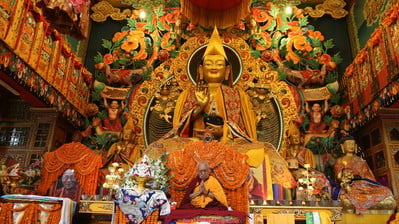Even writing one letter from the Prajnaparamita; even writing one letter, one syllable, the benefits are unbelievable, unbelievable, more than making extensive offerings, skies of extensive offerings to all the buddhas for so many eons. The merits you collect are unbelievable.
Offering one grain of rice or a tiny flower to a picture of the Buddha or a statue of the Buddha, small or big, the benefits are that it brings us up to enlightenment and then we are able to free numberless sentient beings from the oceans of samsaric sufferings and bring everyone to enlightenment. Just by making skies of offerings to numberless buddhas for eons.
Now here, writing one word of the Prajnaparamita, the teachings on emptiness, we create far greater merit than making that many offerings, skies of offerings to numberless buddhas for so many eons.
The benefits are incredible. I read them before I recite the Diamond Cutter Sutra.
The Prajnaparamita in 12,000 verses, we have completed writing four volumes. It was done by Ven. Tsering, one monk from Kopan. I have also started writing the Prajnaparamita in 8,000 verses in gold. Then the Diamond Cutter Sutra was written in silver by Ven. Tsenla. Also, Jane Seidlitz is writing a volume of the Prajnaparamita. She does it well, in good Tibetan writing. So she is slowly writing one Prajnaparamita text.
I haven’t yet managed to organize this, but my idea is to have the monks at Kopan learn well Tibetan writing, then some monks at Kopan can do it together, like that.
My idea is that not only during my life; my idea is even when I die, even when I’m dead, that work, writing the Prajnaparamita texts, can be continued.
This was done to create the cause to build the fifty-story Maitreya Project. To build that, to do that, we need to create the cause, so this is why I started to write the Prajnaparamita. Before I got paralyzed I started to write with real gold.
One time, Kyabje Kirti Tsenshab Rinpoche came and he saw I wrote Gyetongpa [Prajnaparamita in 8,000 verses] with gold, but I didn’t finish since I got paralyzed. I wasn’t able to write after that but there is so much left to write. Kyabje Kirti Tsenshab Rinpoche was saying how fortunate I was, to be able to write the Prajnaparamita.
My idea is that even when I’m dead [for students] to continue this gold writing as much as possible; for it to continue even after I’m dead. I didn’t have that idea at the beginning, but for the last two or three years I’ve had that idea, to do it all the time.
For example, similarly, we build statues or stupas, then even after we are dead, we may be in hell, somewhere far away from this universe, but the stupa or statue we built still benefits sentient beings. For as long as it exists, continuously from life to life, it benefits sentient beings—even the birds, the flies, the people, anybody who sees that holy object—and it brings them to enlightenment. Anybody who can see that, anybody from far or near, from life to life wherever we are born, it benefits sentient beings all the time, as long as it can last, however many years it lasts, hundreds of years.
So like that, I thought to continue the gold writing of the Prajnaparamita.
I would also like [the organization] to continue, after I am dead, making offerings to the stupas, Boudha Stupa and Swayambunath, and also to the Jowo statue in Tibet and the Buddha statue in Bodhgaya, offering robes and offering gold every month. So for these offerings to be continued by the organization, even after I’m dead.
[Read about Rinpoche's resumption of writing the Prajnaparamita on this FPMT blog.]































